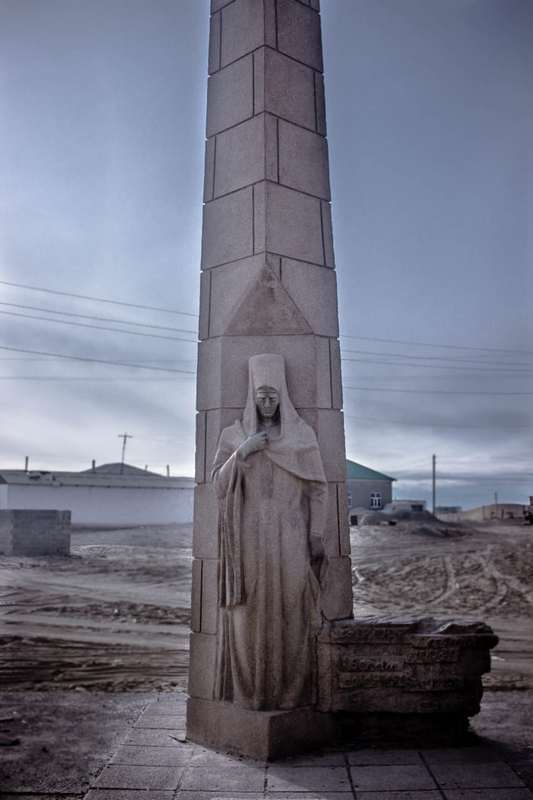An introduction to the Basmachi Monument in Turkmenistan. Turkmenistan Travel Guide.
Basmachi Monument, Turkmenistan
(Erbent/Yerbent)
Basmachi Monument Introduction
Basmachi Monument Location
Basmachi Monument Visiting and History
Updated March, 2024.
Introduction: Basmachi Monument
The Basmachi Monument was built in 1931 to the memory of 11 men who lost their lives combatting the Basmachi revolt.
When you drive from Ashgabat to the Darvaza Gas Crater it is done mostly on the highway running directly north through the Karakum Desert.
While there are no cities you pass, there are several villages along the way. And it is worth taking the time to stop in a couple as time allows.
These settlements are known locally as ‘semi-nomadic villages’. This simply refers to the fact that the people here are traditionally nomadic. And, they would likely still be if they hadn’t been forcibly settled when Soviet Power arrived in this region.

Location of Basmachi Monument
The Basmachi Monument is located in Erbent Village, Turkmenistan.
A visit to Erbent village and the Basmachi Monument is a very worthwhile 15-minute detour when in Turkmenistan.
Get exposed to a complex bit of local history and give yourselves something to discuss as you continue on the drive through the Karakum Desert!
Visiting and History of Basmachi Monument
The largest settlement along this road is the village of Erbent (also written asYerbent).
It is a 2 hours drive from Ashgabat. So, halfway to the gas crater. There is only one reason to stop on Erbent and that is to see a quite poignant monument.
The Monument itself is a tall sandstone tower. It has the date of its erection on the top.
Built into the stele is a Turkmen woman in traditional mourning clothes. At the base is the list of names of those this memorialises; Turkmen and Russians among them.
The Basmachi Revolt (History)
The Basmachi Revolt itself is little known outside of this region. However, at the time was a very big deal.
In brief, it was a broadscale uprising by militant organisations in Central Asia against the rule of initially the Russian Empire and then its successor state, the Soviet Union.
These empires brought with them many ideas, customs, and laws that were considered anathema to certain sections of the population. For example, progressive policies such as banning polygamy and slavery, instituting women’s rights, and promoting universal literacy... But also oppressing religious activity, ending nomadism, etc.
The key starting point is believed to be in 1916 when a policy to conscript troops from Central Asia into the Imperial Army was instituted. This led to breakaway movements in various parts of Central Asia.
As many people had no interest in being killed in WW1 or the Russian Civil War, it spread across the region. It heated up in the early 1920s and gradually petered out as Soviet Power was consolidated and strengthened.
By the late 1920s, the Basmachi revolt was no more. It had come up against a leadership far more ruthless and militarily advanced than could be stood against.
Skirmishes, attacks, and activism continued for a few more years. But by the early 1930s, the game was over.
And Moscow was the winner.
Basmachi Meaning
The term ‘Basmachi’ itself is a derogative one.
A Russian word of Turkish origin, it basically means ‘bandits’. It serves to simplify what was a long and complex series of mini-uprisings as well as larger more significant ones.
Many people in Central Asia these days are proud to have Basmachi roots. They see their relatives as freedom fighters who struggled against foreign occupation and aggression. Even if in reality many of them were opposed to things like allowing women to become literate.
Still, it is complicated and part of a murky mix of histories and clashes of civilisations.
Fascinating indeed, but also mind-bendingly complex!
A decent account of the movement and rebellion can be found on Wikipedia. While there is no definitive book about the rebellion itself, Jonathan D Emele’s The ‘Russian’ Civil Wars covers this (and the other conflicts arising at the same time) very well. It is a fascinating read about this little-known but crucial piece of history.
Koryo Tours
Turkmenistan Tours
Turkmenistan Travel Guide | Sign up to the mailing list | About Koryo Tours